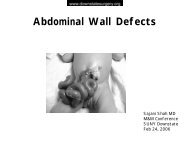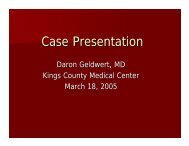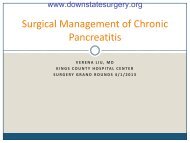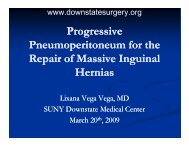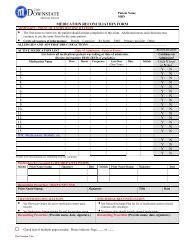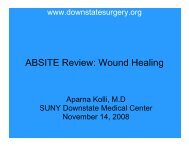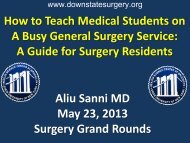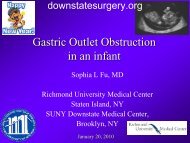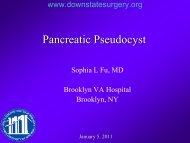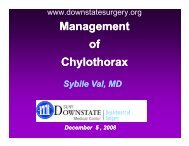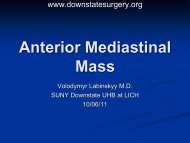Case Presentation Morbidity and Mortality Morbidity and Mortality ...
Case Presentation Morbidity and Mortality Morbidity and Mortality ...
Case Presentation Morbidity and Mortality Morbidity and Mortality ...
You also want an ePaper? Increase the reach of your titles
YUMPU automatically turns print PDFs into web optimized ePapers that Google loves.
www.downstatesurgery.org<br />
<strong>Case</strong> <strong>Presentation</strong><br />
<strong>Morbidity</strong> <strong>and</strong> <strong>Mortality</strong><br />
Conference<br />
Ravi Dhanisetty, M.D.<br />
Kings County Hospital Center<br />
1 May 2009
www.downstatesurgery.org<br />
<strong>Case</strong> <strong>Presentation</strong><br />
• 53 year old male bus driver had a syncopal<br />
episode <strong>and</strong> found down unresponsive.<br />
• Brought to emergency room by EMS<br />
• Initial vitals SBP – 70, HR 120s<br />
• Patient t regained consciousness <strong>and</strong><br />
complained of left flank pain radiating to left<br />
groin.<br />
• Patient was aggressively resuscitated <strong>and</strong> a<br />
CT scan of the abdomen was performed.
www.downstatesurgery.org
www.downstatesurgery.org
www.downstatesurgery.org
www.downstatesurgery.org
www.downstatesurgery.org<br />
<strong>Case</strong> <strong>Presentation</strong><br />
Laboratory values:<br />
• Arterial blood gas - 7.3/27/150/99.6/18/-7.8<br />
• Lactate – 4.7 Hgb / Hct – 9.5 / 30<br />
Emergent surgical consultation obtained.<br />
• Physical Exam:<br />
◦ Patient was in extremis – pale, diaphoretic, tachypnic<br />
◦ Diffusely distended abdomen.<br />
Patient was taken to OR for exploration.
www.downstatesurgery.org<br />
Operative Course<br />
• Giant retroperitoneal hematoma extending from the<br />
inguinal ligament to diaphragm with hemoperitoneum<br />
• Size of hematoma precluded proximal vascular control<br />
outside the hematoma.<br />
• Entered the hematoma <strong>and</strong> proximal control was<br />
attempted by compressing aorta against the spine<br />
• Left sided d medial visceral rotation ti was performed<br />
• Aorta was clamped proximal to a widely ruptured iliac<br />
artery aneurysm.<br />
• A distal clamp was placed on the iliac artery
www.downstatesurgery.org<br />
Operative Course<br />
•By this time, patient lost signs of life<br />
◦Coarse v.fib on the monitor.<br />
•Resuscitation including antero-lateral<br />
thoracotomy with open cardiac massage<br />
failed to revive the patient.<br />
•Intra-operatively, patient received 13 units<br />
of pRBCs.
www.downstatesurgery.org<br />
Ruptured Abdominal Aortic<br />
Aneurysm<br />
Ravi Dhanisetty, MD<br />
May 1, 2009
www.downstatesurgery.org<br />
Ruptured AAA: Background<br />
•Sudden, unheralded event<br />
•13 th leading cause of death<br />
•Usually fatal (70-80%)<br />
80%).<br />
◦Only 50% present to hospital alive.<br />
•Emergent repair of ruptured aneurysms<br />
◦Staggering mortality of up to 50%<br />
•10 X that of elective repair.
www.downstatesurgery.org<br />
Ruptured AAA: Incidence<br />
• Mureebee et al. JVS 2008.
www.downstatesurgery.org<br />
Risk Factors for Developing Aneurysms<br />
•Age – peak prevalence of 6% at 80-85<br />
85<br />
y.o.<br />
•Male Gender<br />
– 4 - 5 x more common.<br />
•Smoking – 8x compared to non-smokers<br />
•Family history <strong>and</strong><br />
◦History of inguinal hernia<br />
•Diabetes <strong>and</strong> female gender – negative<br />
risk factors.
www.downstatesurgery.org<br />
Rupture Risk of Stable Asymptomatic AAA<br />
Greatest Diameter (cm) Annual Rupture Risk (%)<br />
3.0–5.5 0.6<br />
5.6–5.9 5–10<br />
6.0–6.9 10–20<br />
7.0–7.9 20–30<br />
>8.0 30–50<br />
• Elective repair - > 5.5 cm. Growth > 0.5 cm/ 6mo<br />
• Biannual surveillance<br />
• Curi et al. Carmeron 2008.
www.downstatesurgery.org<br />
Risk Factors for Rupture of AAA<br />
Risk Factors Low Risk High Risk<br />
Diameter < 5 cm > 6 cm<br />
Expansion < 0.3 cm /yr > 0.6 cm / yr<br />
Hypertension<br />
Smoking /<br />
COPD<br />
None<br />
None / Mild<br />
Poorly<br />
Controlled<br />
Steroid<br />
Dependent<br />
Family History None Positive<br />
• Gloviczki et al. Townsend,<br />
2007
www.downstatesurgery.org<br />
Natural History<br />
Retrospective review<br />
56 patients with<br />
ruptured AAA <strong>and</strong><br />
no surgical<br />
intervention.<br />
ti<br />
Once decision made<br />
not tto operate:<br />
◦Minimal fluids<br />
◦Average survival<br />
– 10 hours<br />
◦87% alive at 2<br />
hrs. • Lloyd et al, JVS 2004
www.downstatesurgery.org<br />
<strong>Presentation</strong> ti & Initial Management<br />
Two distinct groups (based on hypotension)<br />
◦Hypotension ± known history of AAA or<br />
pulsatile mass<br />
•Free intra-peritoneal rupture<br />
◦No hypotension, or responsive to initial<br />
resuscitation<br />
•Contained / Retro-peritoneal rupture
www.downstatesurgery.org<br />
<strong>Presentation</strong> & Initial Management<br />
DeRubertis, BG et al. Cameron, 2008.
www.downstatesurgery.org<br />
<strong>Presentation</strong> <strong>and</strong> Initial Management<br />
• Patient should be immediately transferred to<br />
operating room <strong>and</strong> all other tests performed<br />
there<br />
• Hypotensive resuscitation may be considered<br />
◦level I rapid transfusion system <strong>and</strong> auto-transfusion<br />
device are a must.<br />
• Prep <strong>and</strong> drape patient prior to induction of<br />
anesthesia.
www.downstatesurgery.org<br />
Surgical Management<br />
Most important step<br />
– control of<br />
hemorrhage by proximal aortic<br />
occlusion:<br />
◦Supra-celiac occlusion or clamping<br />
◦Control of aorta within the hematoma<br />
◦Rarely – antero-lateral thoracotomy with aortic<br />
clamping if patient arrests prior to incision.
Anatomy<br />
www.downstatesurgery.org<br />
WHY NOT INFRA-<br />
RENAL ??<br />
•Hematoma<br />
obscuring veins<br />
•Venous<br />
anomalies
www.downstatesurgery.org<br />
Manual compression of the supraceliac<br />
aorta against the spine<br />
•Temporary<br />
control of<br />
supra-<br />
celiac<br />
aorta.
www.downstatesurgery.org<br />
Supra-Celiac Control of Aorta<br />
• Veith FJ, et al: Surg Gynecol Obste.,1980.
www.downstatesurgery.org<br />
Supra-Celiac Control of Aorta<br />
• Veith FJ, et al: Surg Gynecol<br />
Obste.,1980.
www.downstatesurgery.org<br />
Proximal Control from within the<br />
Ruptured Aneurysm<br />
• In the case of an<br />
uncontained rupture,<br />
a foley catheter can<br />
be inflated in the<br />
supra-renal aorta to<br />
gain rapid proximal<br />
control.
www.downstatesurgery.org<br />
Surgical Management<br />
•Once proximal control is achieved<br />
◦Further dissection can be carried to expose<br />
infra-renal renal portion of aorta to move cross clamp<br />
to infra-renal location<br />
◦Distal control of iliacs – most commonly from<br />
within the aneurysm lumen.<br />
◦Repair of aneurysm with prosthetic graft.
Complications<br />
•Bleeding<br />
www.downstatesurgery.org<br />
◦Secondary to injury to adjacent veins:<br />
•Infra-renal aorta is a large artery surrounded by veins<br />
•Lower Extremity Ischemia<br />
◦Cross clamping, embolization, distal anastomosis.<br />
•Intestinal Ischemia (40%)<br />
◦<strong>Mortality</strong> in up to 80% of patients<br />
•Abdominal Compartment Syndrome
Recent Outcomes:<br />
30 Day <strong>Mortality</strong> after Ruptured AAA<br />
Repair<br />
www.downstatesurgery.org<br />
• Mureebee et al. JVS 2008.
www.downstatesurgery.org<br />
Prognostic Score to Predict Outcome<br />
• Edinburgh Ruptured Aneurysm Score (ERAS)<br />
◦Hemoglobin level 9 g/dL<br />
◦GCS of < 15<br />
◦Blood pressure of less than 90 mm Hg<br />
• Prospective evaluation with 111 patients <strong>and</strong> compared<br />
to other scoring systems (HI, GAS, POSSUM)<br />
• ERAS – only one to accurately stratify peri-operative<br />
risk<br />
• Tambyraja et al. World J. Surg 2008
www.downstatesurgery.org<br />
Prognostic Score to Predict Outcome<br />
◦ Tambyraja et al. World J. Surg 2008
www.downstatesurgery.org<br />
Other Factors Affecting Outcome<br />
Retrospective e review of 213 patients that underwent<br />
ent<br />
open repair of ruptured AAA at a tertiary referral<br />
center.<br />
High vs low volume surgeons (20 cases/year)<br />
• Cho et al. JVS 2008
www.downstatesurgery.org<br />
Other Factors Affecting Outcome<br />
• Cho et al. 2008
Screening<br />
www.downstatesurgery.org<br />
•Consensus Statement in 2004 based on 6<br />
prospective r<strong>and</strong>omized studies.<br />
◦Screening ggeneral population p for AAA<br />
◦High compliance<br />
◦Decreased AAA related mortality (up to 68%)<br />
◦Decrease rupture rate (49%)<br />
◦ Kent et al JVS 2004.
www.downstatesurgery.org<br />
Screening Recommendations<br />
• Kent et al JVS 2004.
Conclusion<br />
www.downstatesurgery.org<br />
•Ruptured AAA continues to be a highly<br />
lethal problem.<br />
•Successful outcomes depend on<br />
establishing correct diagnosis <strong>and</strong> rapid<br />
surgical control of hemorrhage.<br />
•Screening, early detection of aneurysm<br />
<strong>and</strong> elective repair remains most likely<br />
way to reduce aneurysm-related death.
Questions<br />
www.downstatesurgery.org<br />
• Which one of the following is associated with poor<br />
outcome in a patient undergoing repair of rAAA?<br />
a. Peri-operative cardiac arrest<br />
b. Intestinal ischemia<br />
c. Age > 80<br />
d. Initial blood pressure < 90 mm Hg<br />
e. All of the above<br />
• Risk factors associated with development of AAA<br />
include:<br />
a. Smoking<br />
b. Age<br />
c. Family history<br />
d. All of the above
Questions<br />
www.downstatesurgery.org<br />
• Screening is recommended in all of the patients<br />
except:<br />
a. 75 year old male with history of hypertension<br />
b. 65 year old female with history of MI<br />
c. 54 year old male with family history of AAA<br />
d. 75 year old male with aortic diameter of 2.8 cm on a CT scan<br />
a year ago.<br />
• Peri-operative complications of repair of ruptured AAA<br />
include all of the following except.<br />
a. Myocardial Infarction<br />
b. Bleeding<br />
c. Intestinal ischemia<br />
d. Lower extremity ischemia<br />
e. None of the above
Questions<br />
www.downstatesurgery.org<br />
•Initial evaluation of a hypotensive patient<br />
with suspected ruptured AAA include:<br />
a. Rapid assessment <strong>and</strong> transport to operating<br />
room<br />
b. Aggressive resuscitation with fluid <strong>and</strong><br />
pressors<br />
c. CT scan with iv contrast<br />
d. None of the above.
References<br />
www.downstatesurgery.org<br />
• Cameron: Current Surgical Therapy. 9 th ed. 2008.<br />
• Cho et al. Contemporary results of open repair of ruptured abdominal<br />
aortoiliac aneurysms: effect of surgeon volume on mortality. J Vas Surg:<br />
48(1), 2008.<br />
• Dardik et al. Surgical Repair of rAAA in the state of Maryl<strong>and</strong>: Factors<br />
influencing outcome among 527 recent cases. J Vas Surg 28(3), 1998.<br />
• Kent et al. Screening for abdominal aortic aneurysm: A consensus<br />
statement. J Vasc Surg: 39(1), 2004.<br />
• Lloyd et al. Feasibility of pre-operative CT in patients with ruptured<br />
abdominal aortic aneurysm: a time-to-death study in patients without<br />
operation. J Vasc Surg 2004; 39: 788-91.<br />
• Mureebe, et al. National Trends in repair of ruptured AAA. JVS: 48(5),<br />
2008.<br />
• Tambyraja A, Murie J, Chalmers R. Predictors of outcome after abdominal<br />
aortic aneurysm rupture: Edinburgh Ruptured Aneurysm Score. World J<br />
Surg 2007;31:2243-7.<br />
• Tambyraja et al. Prognostic Scoring in Ruptured abdominal aortic<br />
aneurysm: a prospective evaluation. J Vas Surg: 47(2), 2008.<br />
• Townsend: Sabiston Textbook of Surgery, 18 th ed. 2007.<br />
• Veith FJ, Gupta S, Daly V: Surg Gynecol Obstet 151:497,1980.
www.downstatesurgery.org
www.downstatesurgery.org<br />
Other Factors Affecting Outcome
www.downstatesurgery.org<br />
Other Factors Affecting Outcome:<br />
Surgeon Volume
Pathogenesis<br />
www.downstatesurgery.org<br />
•Most are degenerative:<br />
◦Interaction of multiple factors is responsible for<br />
destruction of media of the aortic wall leading to<br />
aneurysm.<br />
◦The balance of aortic wall remodeling favors<br />
elastin <strong>and</strong> collagen degradation.
www.downstatesurgery.org<br />
Components of Aortic Wall<br />
• Elastin <strong>and</strong> collagen are<br />
major structural<br />
components <strong>and</strong> act in<br />
complementary fashion.<br />
• Elastin in media<br />
◦Not synthesized in aorta with<br />
half-life of 40 – 70 yrs.<br />
◦Load-bearing g <strong>and</strong> elastic recoil<br />
• Collagen in adventitia<br />
◦Tensile strength <strong>and</strong> structural<br />
integrity.
Pathophysiology: Aneurysm<br />
Formation<br />
www.downstatesurgery.org<br />
• Histology: aneurysm wall thin <strong>and</strong> marked<br />
decrease in the amount of elastin <strong>and</strong> collagen.<br />
• Elastin degradation / fragmentation: aneurysmal<br />
formation, elongation, <strong>and</strong> tortuosity<br />
• Collagen degradation: aneurysmal rupture<br />
• Primarily by proteolytic enzymes<br />
◦Either over expression or decreased expression of<br />
protease inhibitor (alpha –1 antitrypsin or tissue<br />
inhibitors of MMP (TIMPs)).
www.downstatesurgery.org<br />
Pathophysiology: enlargement.<br />
•Laplace’s s Law:<br />
◦ T (tangential stress) = P (tangential pressure) x R / δ<br />
•Size <strong>and</strong> hypertension are important risk<br />
factors in the rate of enlargement.



